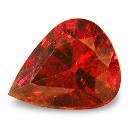|
|
||||||||||||||||
|
||||||||||||||||
|
||||||
|
|
|
|
Spessartine (variety
of Garnet) |
|
| | |
| Discovered in 1832; IMA status: Valid (pre-IMA; Grandfathered) | ||
|
| ||
|
Chemistry |
|
|
| |
|
Mn2+3Al2(SiO4) | |
|
|
Manganese Aluminum Silicate |
|
Molecular Weight: |
495.03 gm |
|
Composition: |
Manganese |
33.29 % |
Mn |
42.99 % |
MnO |
|
|
Aluminum |
10.90 % |
Al |
20.60 % |
Al2O3 |
|
|
Silicon |
17.02 % |
Si |
36.41 % |
SiO2 |
|
|
Oxygen |
38.78 % |
O |
|
|
|
|
|
100.00 % |
|
100.00 % |
= TOTAL OXIDE |
|
|
|
||||
|
Classification |
|
|
| |
|
Silicates (Germanates) | |
|
8/A.08-30 | |
|
|
9 : SILICATES (Germanates)
|
|
Related to: |
Garnet Group. Almandine-Spessartine Series. |
|
Members of Group: |
Garnet Group: Almandine, Andradite, Grossular, Pyrope, Spessartine, Uvarovite |
|
Varieties: |
Brandãosite, Calcium-Eisenspessartin, Emildine, Spandite |
|
Synonyms: |
Erinite (of van der Lingen), Mandarin Garnet, Partschinite, Spessartine Garnet, Spessartite |
|
|
|
|
Crystal Data |
|
|
|
|
|
Commonly as euhedral crystals, dodecahedra or trapezohedra, or in combination with other cubic forms, to 10 cm. Fine or coarse granular, compact, massive. |
|
|
None |
|
|
|
|
|
Physical Properties |
|
|
|
|
|
None (?) |
|
|
Irregular/Uneven to Conchoidal |
|
|
Brittle |
|
|
7.0 - 7.5 |
|
|
4.190 (g/cm3) |
|
|
None |
|
|
Not Radioactive |
|
|
|
|
|
Optical Properties |
|
|
|
|
|
Red, reddish orange, yellow, yellowish brown, reddish brown, brown, black; pale pink to pale brown in thin section, may be sectored. |
|
|
Transparent to Translucent |
|
|
Vitreous |
|
|
1.800 Isotropic |
|
|
0.000 (Isotropic) |
|
|
Weak |
|
|
None |
|
|
May show weak anisotropism. |
|
|
|
|
|
Occurances |
|
|
|
|
|
Geological Setting: |
Common in granite pegmatites, granites, and rhyolites. Formed in some skarns and metasomatic manganese-rich rocks adjacent to igneous intrusions or in regionally metasomatized areas. |
|
Common Associations: |
Quartz, Potassic Feldspar, Tourmaline, Rhodonite, Pyroxmangite, Tephroite, Alleghanyite, Galaxite, Muscovite, Topaz, Apatite, Beryl, Albite, Bixbyite, Pseudobrookite. |
|
Common Impurities: |
None |
|
Type Locality: |
Sommer quarry, Wendelberg, Haibach, Aschaffenburg, Spessart, Franconia, Bavaria, Germany |
|
Year Discovered: |
1832 |
|
View mineral photos: | |
|
|
|
|
More Information |
|
|
|
|
|
| |
|
|
|
|
Rare color change Garnets with large amounts of vanadium (V) and chromium (Cr) have been reported from East Africa. These are primarily Spessartine, with an unusually large component of Grossular. There are generally two types of color change displayed: either greenish yellow-brown in fluorescent light to purplish red or reddish orange in incandescent light; or light bluish green in fluorescent light to purplish red or red in incandescent light. So-called Alexandrite-like Garnets are also found from Bekily, Madagascar. These gems display a distinct color change from violet-red to blue-green. Spessartine, like other garnets, forms rounded crystals with 12 rhombic or 24 trapezoidal faces or combinations of these and some other forms. This crystal habit is classic for the Garnet minerals. Spessartine is formed in manganese rich metamorphic environments and in some granitic pegmatites. Distribution:
While a less-common garnet, nevertheless many localities.
From Aschaffenburg, Spessart Mountains, Bavaria, Germany.
On Seriphos, Cyclades Islands, Greece. In the USA, in
Leiper's quarry, Avondale, Delaware County, Pennsylvania;
the Rutherford mine, Amelia, Amelia County, Virginia;
in the Ramona and Pala districts, San Diego County,
California; from the Thomas Range, Juab County, Utah;
at Ely, White Pine County, Nevada; from near Nathrop,
Chaffee County, Colorado. In Brazil, from Nangue and
Urucum, Minas Gerais, and at Carnaúba, near Picui, Rio
Grande do Norte. From Marienflüss, Namibia. At Tsilaizina
and Anjanabonoina, Madagascar. In the Gilgit district,
and at Dusso, Baltistan, Pakistan. From Broken Hill,
New South Wales, Australia. At Wada-toge Pass, Nagano
Prefecture, Japan. |
|
|
We
have not photographed our Spessartine gems yet. Please
check back soon. |
